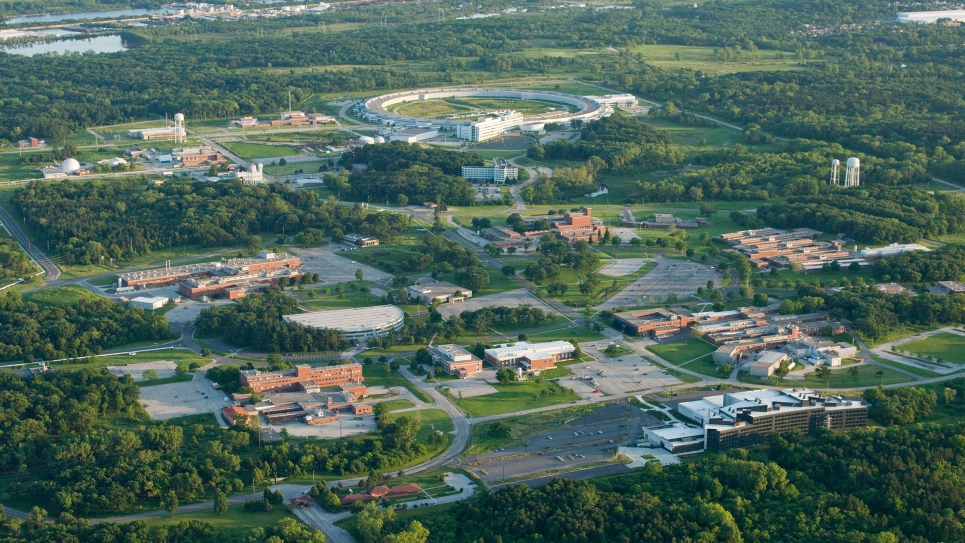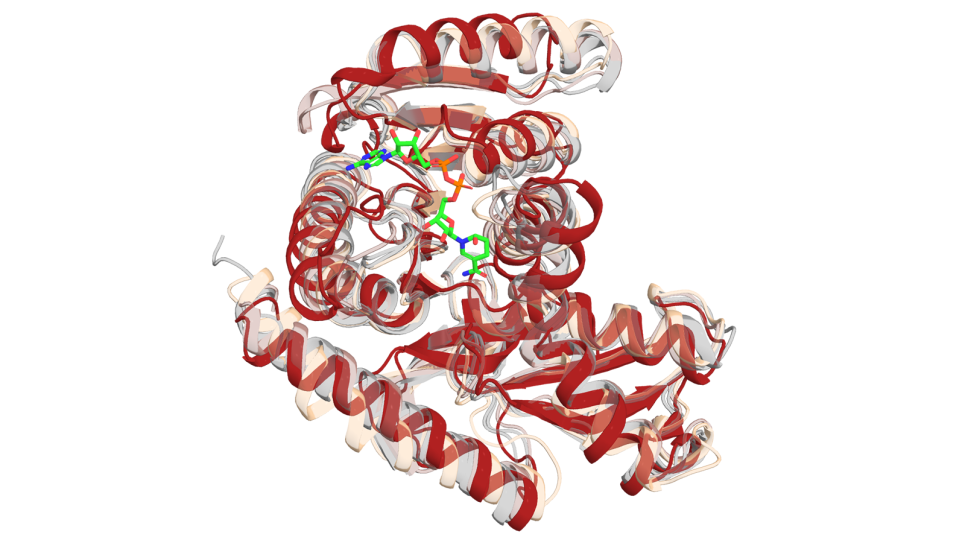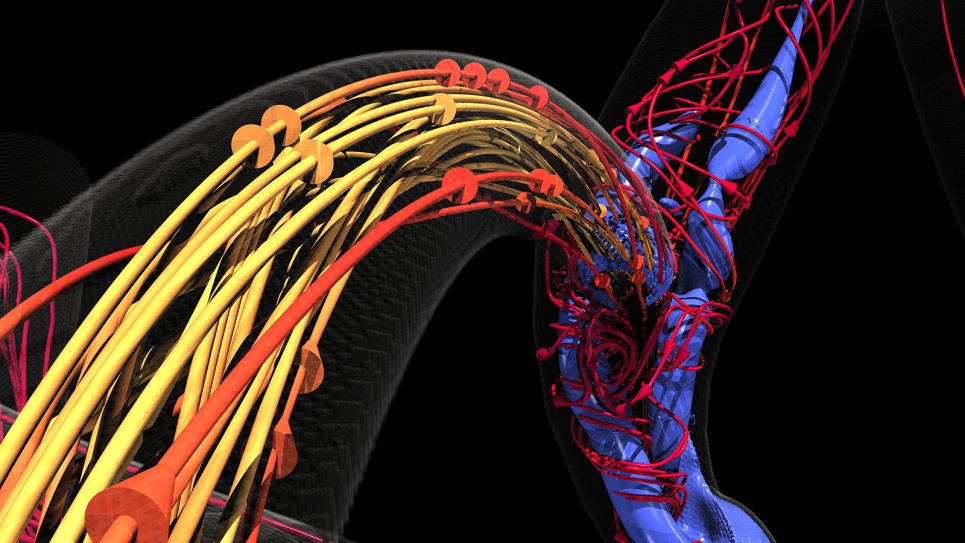
Argonne’s user facilities continue to enable critical work combating and addressing the impacts of the COVID-19 epidemic
Argonne researchers and facilities continue work to fight COVID-19.
The Advanced Photon Source (APS), a U.S. Department of Energy (DOE) Office of Science User Facility located at the DOE’s Argonne National Laboratory, continues to work with user groups around the country on COVID-19 research. With the laboratory in minimum safe operations mode, that research is being conducted remotely.
As of June 1, a total of 45 different groups have used or are using the APS via remote access for research on the SARS-CoV-2 virus, which causes COVID-19. Those groups have deposited 44 structures of the proteins that make up the virus, some with inhibitors and antibodies, into an international protein databank maintained by scientists from around the world. Members of the Center for Structural Genomics of Infectious Diseases (CSGID) have contributed 30 of the 44 structures. The CSGID is led by Karla Satchell at Northwestern University and Andrzej Joachimiak at Argonne and the University of Chicago.
According to Robert Fischetti, group leader with Argonne’s X-ray Science division and life sciences advisor to the APS director, the APS has been proactive, contacting more than 15,000 users to let them know that remote access or mail-in research on COVID-19 is ongoing. Proposals for COVID-19 research are being fast-tracked, Fischetti said, but still undergoing review for safety, and to make sure all accepted proposals are actually for work on SARS-CoV-2.
Scientists at the APS do not work with the live virus, but with crystals grown from noninfectious viral proteins. The APS has 68 beamlines and 16 of them are used for protein or macromolecular crystallography. Users apply for time on these beamlines, and once approved and scheduled, they ship crystals for analysis. If users need crystals grown for their research, Argonne’s Structural Biology Center (SBC) team can do that for them as well, according to Joachimiak, director of the Midwest Center for Structural Genomics and the SBC at the APS.
From there, Fischetti said, the process is almost entirely remote. Using a system built and tested over the past 15 years, users can control the APS beamline from any computer remotely, as if they were sitting at the experiment station on site. The crystals are automatically loaded into the beamline, and scans take only a few minutes. Users can determine from afar which crystals they most want to analyze and can get data back from their scans in minutes. A few other beamlines are applying X-ray imaging and small-angle X-ray scattering (SAXS) techniques to study SARS CoV-2 proteins and materials for N95 masks.
Some projects, Joachimiak noted, require further interaction with beamline scientists. Users can mail in their samples for the SBC team to conduct the scans. Mail-in COVID-19 research is currently happening at a few beamlines, Joachimiak said.
Once the scans are complete and data transmitted, it’s up to the user to deposit the completed structures into the protein databank, Fischetti said. While much of the research involves determining the exact shape of the proteins that make up the virus to lay the groundwork for potential treatments, several users are working with antibodies from previous SARS and MERS outbreaks to chart the path toward a vaccine.
Joachimiak also noted the integration of computing and other resources enabling faster and more precise work on COVID-19. He noted that the current effort has progressed as much in two months as the research on the previous SARS epidemic did in four years, and called for even more cooperation and connection moving forward.
“This is direct evidence that we can do this,” he said. “There will be other viral outbreaks in the future, and the more we work together the better prepared we will be.”
Another collaboration between the University of Chicago (UChicago) and DOE’s Argonne National Laboratory is turning to artificial intelligence (AI) to extract COVID-19 signatures from medical images.
With a grant from the newly formed C3.ai Digital Transformation Institute (C3.ai DTI), the team is developing a clinical tool to aid in the triaging of COVID patients through the use of AI-informed data drawn from lung X-rays and CT scans of former COVID-19 patients. The team is currently focusing on the lungs, where the virus predominantly settles and presents as a respiratory illness.
The AI technique they’re using is called transfer learning, which stores knowledge gained while solving one problem and applies it to a different but related problem.
“Deep learning models trained in detecting and classifying various interstitial diseases from chest X-rays and CTs are then trained on images from COVID-19 subjects to increase the overall accuracy of our models,” said Ravi Madduri, a computational scientist in Argonne’s Data Science and Learning division and a senior scientist with the University of Chicago Consortium for Advanced Science and Engineering.
Madduri is working alongside UChicago computer-aided diagnosis expert and the project’s principal investigator Maryellen Giger to develop the tool as an efficient means to detect, monitor, and treat patients.
“There are multiple parts: the detection and diagnosis, as well as the response to treatment,” Giger said in a recent article in UChicago News. “How do we follow the disease? And when do we see a presentation that says ‘start treatment’? And if they are being treated, how can we follow to determine if the treatment is working? Can we use this to inform decisions and treatment?”
To help answer some of those questions, Madduri will work with Giger’s group in overall data management, viral feature extraction and in leveraging Argonne’s high-performance computing resources, including the Argonne Leadership Computing Facility, another DOE Office of Science User Facility, to scale up the learning and inferencing from the models.
“The most immediate impact of our developments will be an early-stage tool for surveillance and early detection of COVID-19 resurgence via monitoring of lung CT/X-Ray scans,” said Madduri.
C3.ai DTI was founded by C3.ai, Microsoft Corporation, the University of Illinois at Urbana-Champaign (UIUC), the University of California, Berkeley, Princeton University, the University of Chicago, the Massachusetts Institute of Technology, Carnegie Mellon University, the National Center for Supercomputing Applications at UIUC, and the DOE’s Lawrence Berkeley National Laboratory.
Finally, in response to growing interest and need for homemade masks to protect the public from COVID-19, University of Chicago and Argonne scientists are using the Center for Nanoscale Materials (CNM), a third DOE Office of Science User Facility, to investigate the effectiveness of various combinations of household materials at filtering aerosol particles ranging from 10 nanometers to six microns in size.
A recent study published in ACS Nano suggests that a combination of high thread-count cotton and natural silk or chiffon can effectively filter aerosol particles of similar sizes to respiratory droplets that spread the virus through coughs, sneezes, and breaths.
The team, led by Supratik Guha, a professor with the University of Chicago’s Pritzker School of Molecular Engineering (PME) and a scientist at Argonne, designed an experimental setup consisting of two plexiglass boxes connected by a tube. The scientists placed different combinations of cloths over the tube, and a fan blew aerosol particles at the fabric samples. The researchers — with help from Argonne environmental safety experts Mike Schmoldt and Greg Moss — determined the percentage and size of particles that made it through to the other side of the fabric through the use of particle analyzers. The research team also included CNM postdoctoral fellows Abhinav Prakash and Abhiteja Konda and PME graduate student Greg Grant.
The results of the study indicate that one layer of tightly woven cotton or flannel, combined with two layers of polyester-based chiffon or natural silk, filtered out between 80 to 90 percent of aerosol particles, depending on particle size. However, this will also significantly reduce the flow of air through the cloth at pressure drops that realistically occur across the fabric of unfitted cloth masks. The path to innovative cloth mask designs is to identify ways of increasing the surface area of the cloth in order to increase flow, while reducing the relative effects of air leakage around the edges of the mask.
Tightly woven fabrics, such as cotton, can act as a mechanical barrier to particles. Fabrics that hold a static electric charge, such as chiffon and silk, stop even the smallest particles using an electrostatic barrier. However, the researchers note that even a small gap between the face and a mask could reduce filtering efficiency by half or more, emphasizing the importance of a properly fitted mask.
About Argonne’s Center for Nanoscale Materials
The Center for Nanoscale Materials is one of the five DOE Nanoscale Science Research Centers, premier national user facilities for interdisciplinary research at the nanoscale supported by the DOE Office of Science. Together the NSRCs comprise a suite of complementary facilities that provide researchers with state-of-the-art capabilities to fabricate, process, characterize and model nanoscale materials, and constitute the largest infrastructure investment of the National Nanotechnology Initiative. The NSRCs are located at DOE’s Argonne, Brookhaven, Lawrence Berkeley, Oak Ridge, Sandia and Los Alamos National Laboratories. For more information about the DOE NSRCs, please visit https://science.osti.gov/User-Facilities/User-Facilities-at-a-Glance.
The Argonne Leadership Computing Facility provides supercomputing capabilities to the scientific and engineering community to advance fundamental discovery and understanding in a broad range of disciplines. Supported by the U.S. Department of Energy’s (DOE’s) Office of Science, Advanced Scientific Computing Research (ASCR) program, the ALCF is one of two DOE Leadership Computing Facilities in the nation dedicated to open science.
Argonne National Laboratory seeks solutions to pressing national problems in science and technology. The nation's first national laboratory, Argonne conducts leading-edge basic and applied scientific research in virtually every scientific discipline. Argonne researchers work closely with researchers from hundreds of companies, universities, and federal, state and municipal agencies to help them solve their specific problems, advance America's scientific leadership and prepare the nation for a better future. With employees from more than 60 nations, Argonne is managed by UChicago Argonne, LLC for the U.S. Department of Energy's Office of Science.
The U.S. Department of Energy's Office of Science is the single largest supporter of basic research in the physical sciences in the United States and is working to address some of the most pressing challenges of our time. For more information, visit https://energy.gov/science


